http://www.31stinfantry.org/wp-content/uploads/2016/06/A-History-of-The-Polar-Bears-June-2016.pdf |
Corporal Ignac
D. Senkyrik U. S. Army Prisoner of War August 25, 1910 - February 17, 1945
Gold Star Mother |
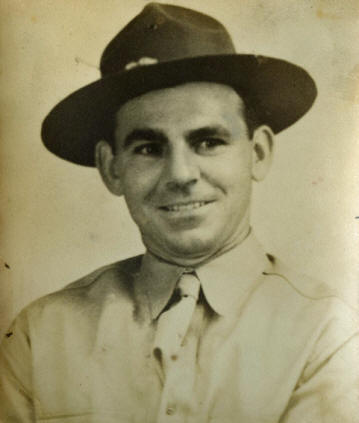 |
||||||||||||||||
|
||||||||||||||||||
|
By
Ken Thames
Joining the Army in February 1941, he was stationed in California for a short while before sailing to the Philippines where he was attached to the 31st Infantry Regiment--"the Polar Bears--America's Foreign Legion"-- a subordinate unit of the Philippine Division – officially the 12th Infantry Division – which was the core of the U.S. Army’s Philippine Department. On July 31, 1941, the division consisted of 10,473 troops, mostly enlisted Filipinos, known as the Philippine Scouts. All of the division’s enlisted men, with the exception of the 31st Infantry Regiment, and various military police and headquarters troops were Philippine Scouts. The Japanese launched their main invasion of the Philippines on December 22, 1941. The American air forces in the islands had either been transferred to Australia or had been destroyed, and the U.S. Navy was completely out of the picture. Only the newly mobilized and poorly equipped Philippine Army stood in the way of the Japanese. General Douglas MacArthur’s army had begun training only four months earlier and was completely unprepared to fight the Japanese. When the Japanese Fourteenth Army came ashore at Lingayen Gulf, MacArthur’s beach defense troops, composed solely of recently drafted Philippine Army soldiers, collapsed. After two days of fighting and delaying actions near the beaches, MacArthur decided to retreat to the Bataan Peninsula. His army fought a series of delaying actions as they withdrew south toward Bataan. The poorly trained Philippine Army soldiers held in some places but fled in others. The elite Philippine Scout 26th Cavalry, American light tanks, and Filipino and Scout artillery were the only units that could successfully fight the Japanese. Because the Japanese were more concerned with capturing Manila, they sent only modest forces against the Philippine Army as it entered Bataan. The Americans would keep the Japanese out of the peninsula for as long as they could. Any time gained would be put to good use by divisions of Filipinos and Americans as they dug in on their new lines. The only real hope of delaying the Japanese was to position the U.S. 31st Infantry Regiment directly in their path. The 31st Infantry went on line at Layac, with Philippine Army soldiers on its right and the 26th Philippine Scout Cavalry on its left. There, at the northern approaches to Bataan, American infantrymen would first face the Japanese. Subsequently, the 31st fought at the Abucay hacienda, where it launched a counterattack against a Japanese penetration of the II Philippine Corps’ left flank. The regiment fought grimly for eight days but could only blunt the Japanese advance. Nothing the American infantrymen tried could evict the determined Japanese 65th Brigade. When MacArthur realized the American counterattack had failed, he decided to withdraw the entire army to its reserve battle position. The 31st Infantry remained in reserve through February and March 1942, suffering continuously from starvation and sickness. The men were called upon one last time in early April to counterattack Japanese penetrations of Filipino lines. The Americans were now so weak that many could not make the march into combat. The starving men cautiously probed into the Japanese advance force and stalled the enemy for a short time. With only 800 men remaining and both flanks open and threatened, the regiment was forced to retreat, leaving only small groups of men to fight the last, hopeless delaying actions. The Japanese pushed to the southern reaches of Bataan. By the time Bataan surrendered on April 9, 1942, the 31st Infantry had been destroyed. It had however, fought to the last and had sustained its motto, Pro Patria (For Country). They buried their colors to keep them out of Japanese hands. On April 10, 1942 [newspaper erroneously reported May 10] Dick became a Prisoner of War (POW) of the Imperial Japanese Army. He survived the 60 mile Bataan Death March. The “march” or forcible transfer of 75,000 American and Filipino prisoners of war, was characterized by wide-ranging physical abuse and murder, and resulted in very high fatalities inflicted upon prisoners and civilians alike by the Japanese. Beheading, throat-cutting, and shooting were common causes of death, in addition to death by bayonet, disembowelment, rifle-butt beating, and deliberate starvation or dehydration on the week-long continual march in the tropical heat. Falling down, or inability to continue moving was tantamount to a death sentence, as was any degree of protest. Prisoners were attacked for assisting someone falling due to weakness, or for no reason whatsoever. Trucks were known to drive over those who fell or succumbed to fatigue, and Japanese “clean-up crews” put to death those too weak to continue. The treatment of the American prisoners was characterized by its dehumanization, as the Imperial soldiery felt they were dealing with sub-humans and animals. Once the prisoners arrived in the area of San Fernando, they were crowded into boxcars and taken to Camp O’Donnell located at Capas, in north central Luzon. Packed like sardines, suffocating in the summer heat, and those suffering from dysentery defecating on each other, many died “standing up”. Four hours later they detrained at Capas and were forced to march the remaining distance to Camp O’Donnell. Here they were housed in Nipa shacks that had formerly been used by the Filipino Army training units. About 1,500 American and 22,000 Filipino prisoners of war died at Camp O’Donnell from starvation, disease and the brutal treatment received at the hands of their captors. Again, Dick survived. The correspondence shown with this article originated at Camp O’Donnell. On July 6, 1942, all of the American prisoners at Camp O’Donnell were evacuated in small groups to another camp at Cabanatuan, a short distance west of the town by the same name, except for 156 seriously ill patients and 43 officers and men. It was at Cabanatuan the American POWs meet up with their fellow countrymen captured on Corregidor and who fortunately did not have to participate in the Bataan Death March. Camp O’Donnell, at the time of the evacuation was in an appalling condition. Epidemics of malaria and dysentery were rampant throughout the camp; all members of the camp were suffering from malnutrition as well. There were no medicines other than a few aspirin tablets, a little tape and a few bandages. The sanitary conditions of the camp, were of the crudest form and fashion and more harmful than sanitary. It is unknown how long Corporal Senkyrik remained at Cabanatuan, but he eventually was transported to the Japanese Islands. It is known he was interned at Camp Fukuoka, Kyushu, Japan, and after suffering over three years of brutal dehumanizing captivity died of acute colitis at Camp Moji (hospital) Fukuoka # 4 on February 17, 1945. He was 34 years old. All POWs returned to the Japanese home islands were utilized as slave laborers in all types of work; at the Moji Branch Camp where Dick died, the prisoners were used by the Kanmon Harbor Transport Company, in all types of dock labor. When they died their remains were cremated in accordance with Japanese custom and usually stored in one of the local temples; it is unknown if Dick's cremains were kept or not. Corporal Ignac "Dick" Senkyrik, Jr., U.S. Army never came home.* He was survived by his parents; four brothers: Joe H., Frank, Louis, and Jerome H; five sisters: Mrs. Mary Sykora, Mrs. France Kristynik, Mrs. Angeline Bane, Mrs. Albina Gauthier and Miss Leona Senkyrik. His parents were living at Markham when they received the delayed word of his death in November 1945. *On October 12, 2019 it was found Corporal Senkyrik had been cremated according to Japanese custom, and a record of his cremation had been maintained by the Japanese. His cremains, though comingled with others, was found to be at the Yokohama Cremation Memorial located at Yokohama, Yokohama-shi, Kanagawa, Japan. The memorial is situated inside the Yokohama British Commonwealth War Cemetery.
“The men and women who suffered
through the atrocious conditions of internment deserve our utmost
gratitude and respect. Their fortitude serves as an example of
placing the ideals of freedom and self-government above one’s own
interests. Many thousands gave their lives as the ultimate
sacrifice, both on the battlefield and in the deadly prison camps of
the Pacific and Europe.” US President George W. Bush, 2001 |
||||||||||||||||||
|
Sgt. I. G. (Dick) Senkyrik, son of Mr. and Mrs. I. G. Senkyrik of Markham, is now a Japanese prisoner on the island of Honshu, according to a War Department message received last week by his parents. Sgt. Senkyrik went into the army before Pearl Harbor and had been in the Philippines about six months when war was declared. He was taken prisoner at the fall of Corregidor and was moved to the Japanese home island ahead of the return of the U. S. forces. The message reported him in good health. Sgt. Senkyrik is a graduate of El Campo high school.
Matagorda County Tribune, July 19, 1945 |
||||||||||||||||||
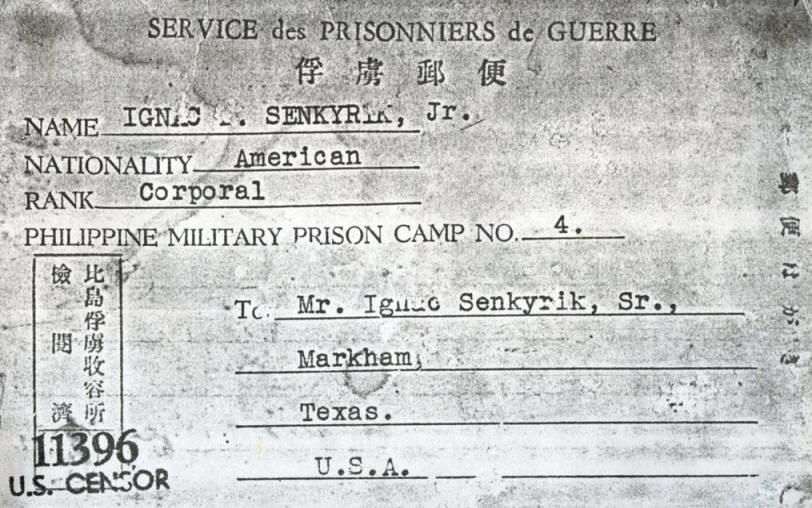 |
||||||||||||||||||
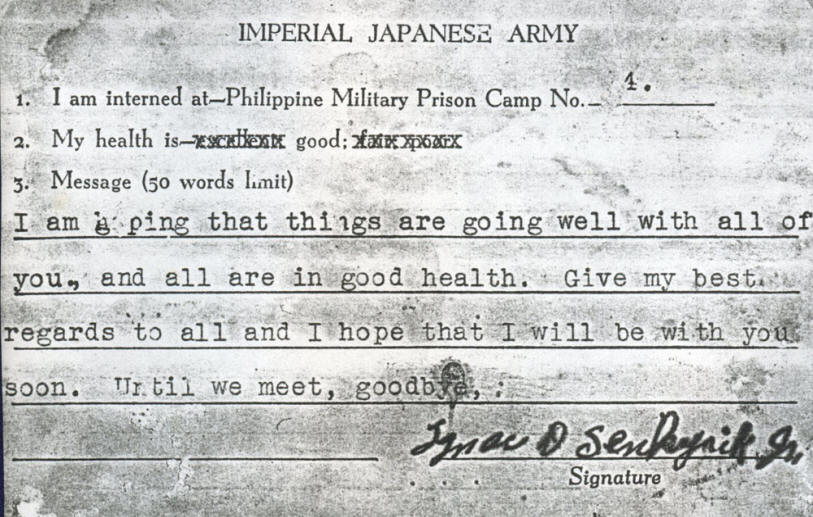 |
||||||||||||||||||
|
Mr. and Mrs. Ignac Senkyrik of Markham, just received a delayed report that their son, Corporal Ignac Dick Senkyrik, Jr., died as the result of acute colitis on February 17, 1945, while being held a prisoner in the Japanese territory. Corporal Senkyrik entered the service in February 1941 and was stationed in California for a short period before sailing for the Philippines. There he was captured on May 10, 1942 and held as prisoner of war of Japanese government in Camp No. 1. Later he was among the group transferred to Camp Fukanka on Hanshu Island. Corporal Senkyrik attended school in El Campo. He was 34 years of age. Before entering the service he was employed by the Lyer Oil Company. He is survived by his parents, Mr. and Mrs. Ignac Senkyrik, four brothers, Joe H., Frank, Louis Jr., and Jerome H; five sisters, Mrs. John Sykara of El Campo, Mrs. A. C. Kristynik, Mrs. Larry M. Bane, Mrs. Marvin G. Gauthier and Miss Leona Senkyrik. Frank, Louis and Jerome have all recently been discharged from the service.
Memorial services will be held at the Blessing Catholic Church
on Tuesday, December 4, at 9:00 a. m.
|
||||||||||||||||||
|
Memorial services were held Tuesday morning at 9 at the Catholic Church in Blessing for Ignac Senkyrik Jr., 36 years old, who died in a Jap prison camp February, 1945 after having been held a prisoner for more than three years. The American Legion Post No. 11 of Bay City and the Texas State Guard Co. E., joined in the ceremonies. Father H. L. Bauman of Blessing delivered the sermon. Taylor Bros. were in charge of the services. The firing squad was composed of Lt. Arthur Bailey, Cpl. Albert Legg, Sgt. M. A. Dornak, Sgt. Ira Rose, Cpl. H. A. Lewis and John A. Hagler, all of the Texas State Guard. The members of the Legion of Bay City post were Eddie Palmer, Joe Wolffarth, Charles Yeamans, H. H. Turner, Jesse Smith and E. H. Powers. Following
the sermon the flag was removed from the casket by Commander Joe
Wolffarth and Adjutant E. H. Powers, folded and handed to Chaplain
C. V. Yeamans who presented it to the mother of the soldier, Mrs.
Ignac Senkyrik, Sr. The firing squad, composed of the Texas Guard
members, then fired a volley of three shots. This was followed by
the bugler, Eddie Palmer, giving
taps.
|
||||||||||||||||||
Photo courtesy of Find A Grave volunteer Michel Nelis #47603165 |
||||||||||||||||||
|
Information from the WWII POW Database in the National Archives.
|
||||||||||||||||||
|
|
||||||||||||||||||
|
Senkyrik, Mrs. Josephine Elenora, born in Moravia, Czechoslovakia, and a former resident of Matagorda County, passed away October 3, at 85 years of age. Services were held at St. Phillips Catholic Church in El Campo on October 5, with Father Hubertus officiating. Mrs. Senkyrik was one of Matagorda County's Gold Star Mothers, for which President Truman sent her a Golden Eagle pin with four stars and was honored annually on this occasion by El Campo American Legion Auxiliary. Survivors include her husband of 64 years, Ignac Senkyrik of El Campo; four sons, Joe of Markham, Frank of Dallas, Louis of Van Vleck and Jerome of Cedar Lane; five daughters, Mrs. A. C. Kristynik, Mrs. Jerome Kovar and Mrs. M. S. Gauthier of Bay City; Mrs. Mary Sykora of El Campo, and Mrs. Nancy Bane of Houston. One son, Ignac "Dick" Senkyrik died in a Japanese prisoner of war camp in 1945. Other survivors include 26 grandchildren and 26 great-grandchildren. Pallbearers were her
grandsons: Raymond Sykora of El Campo, David Kristynik of Ft. Worth,
Larry Bane of Houston, Louis Senkyrik of Van Vleck, Mark Senkyrik of
Cedar Lane, Joe Henry Senkyrik, Thomas Kovar and Tony Gauthier of
Bay City. Honorary pallbearers were
The Triska Funeral Home was in charge of arrangements and interment was in the Garden of Memories Cemetery. The Daily Tribune,
October 8, 1970 |
||||||||||||||||||
|
||||||||||||||||||
|
||||||||||||||||||
|
Survivors include: daughters, Mrs. Mary Sykora of El Campo, Mrs. Angeline Bane of Houston, Mrs. Frances Kristynik, Mrs. Albina Gauthier and Mrs. Leona Kovar all of Bay City; sons, Joe of Markham, Frank of Dallas, Louis of Van Vleck, and Jerome of Cedar Lane; 1 sister, Mrs. Maria Gahura of Fresno, California; 26 grandchildren, 28 great grandchildren and 1 great great grandchild. Rosary will be recited at the Triska Funeral Chapel Thursday night at 7:30 p.m. Funeral services will be held Friday morning at the Triska Funeral Chapel at 9:45 a.m. followed by Mass at the St. Phillips Catholic Church with Father Herbatus officiating. Interment will be at the Garden of Memories cemetery with his grandsons serving as pallbearers. The Daily Tribune,
September 13, 1973 |
||||||||||||||||||
|
Picture of Cpl. Senkyrik in uniform and card images courtesy of the Senkyrik Family on loan from Philip H. Parker VFW Post 2438. |
||||||||||||||||||
|
Copyright 2006 -
Present by Carol Sue Gibbs |
|
| Created Jan. 30, 2006 |
Updated Oct. 27, 2019 |
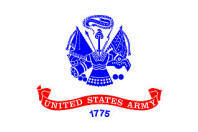
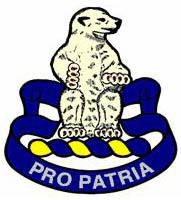



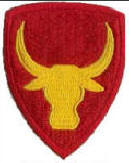
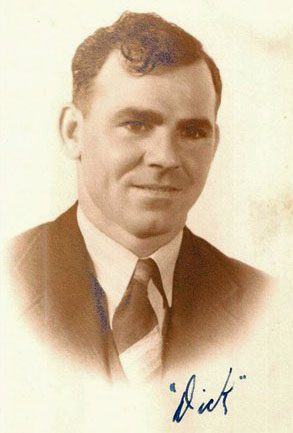
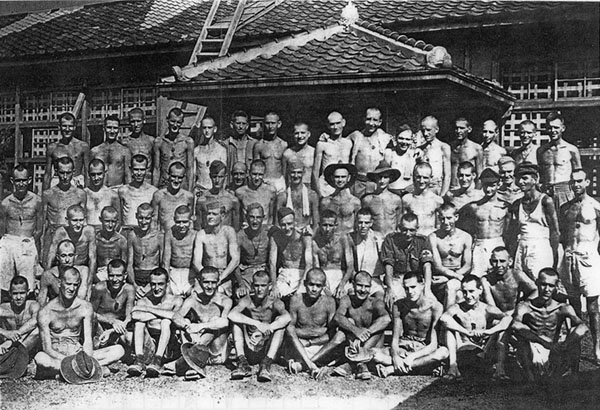
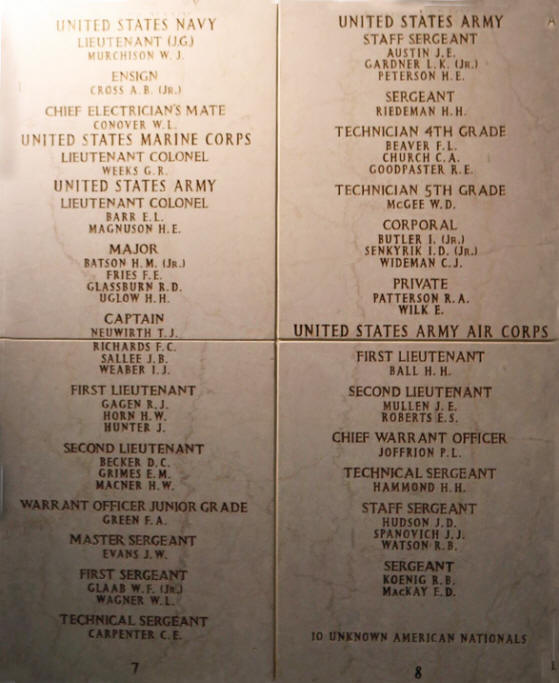
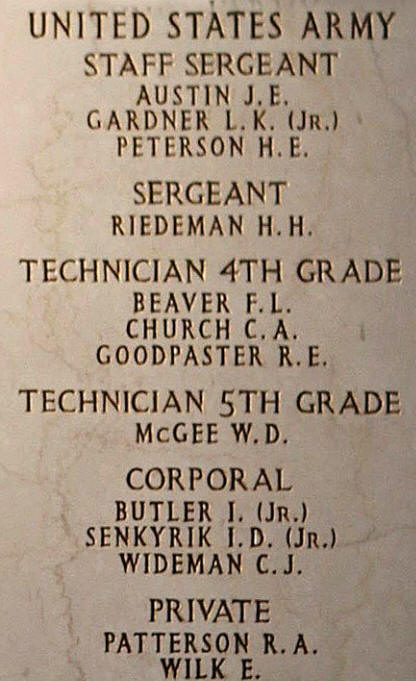
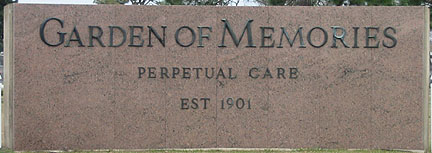
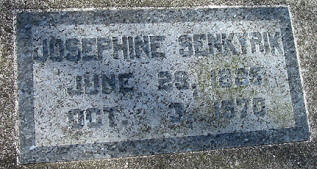 grandsons Frank Senkyrik, Jr.,
Marvin and Paul Kristynik, Richard Kovar, Johnny and George Sykora,
Michael and Alan Gauthier.
grandsons Frank Senkyrik, Jr.,
Marvin and Paul Kristynik, Richard Kovar, Johnny and George Sykora,
Michael and Alan Gauthier.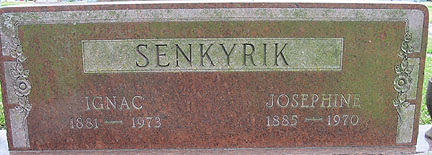
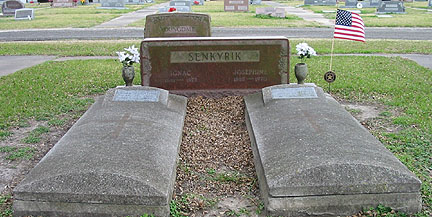
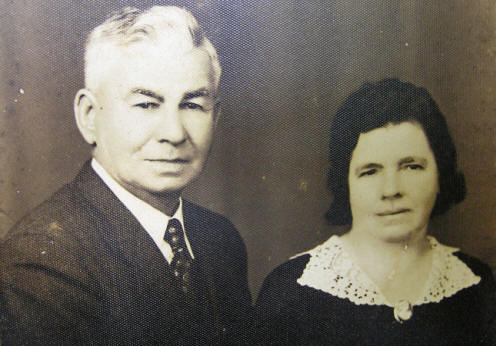
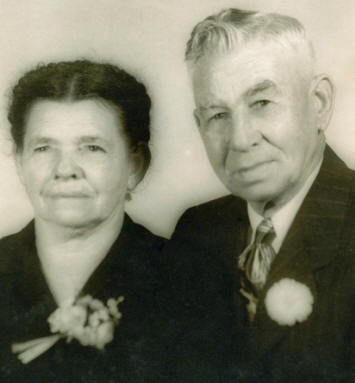
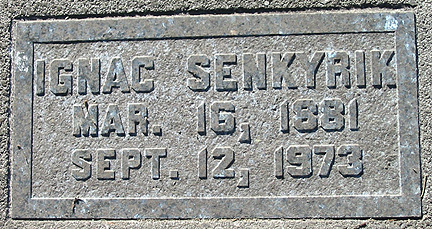 Ignac Senkyrik, 92, passed
away at the Nightingale Hospital in El Campo Wednesday, September
12. He was born in Czechoslovakia on March 16, 1881, to Maria Zelik
and Joseph Senkyrik. Prior to his retirement he was affiliated with
the S.P.J.S.T Insurance Co. for 35 years. His wife Josephine and one
son, Ignac "Dick" Senkyrik preceded him in death.
Ignac Senkyrik, 92, passed
away at the Nightingale Hospital in El Campo Wednesday, September
12. He was born in Czechoslovakia on March 16, 1881, to Maria Zelik
and Joseph Senkyrik. Prior to his retirement he was affiliated with
the S.P.J.S.T Insurance Co. for 35 years. His wife Josephine and one
son, Ignac "Dick" Senkyrik preceded him in death.